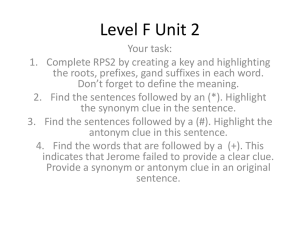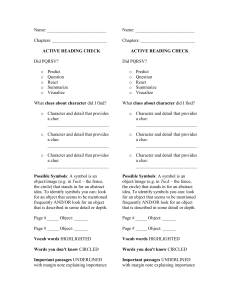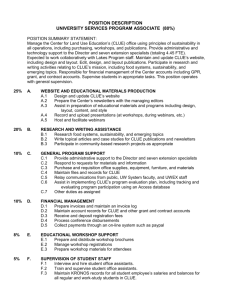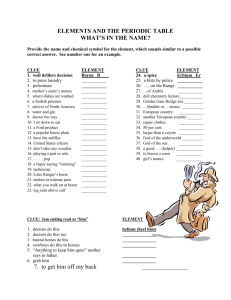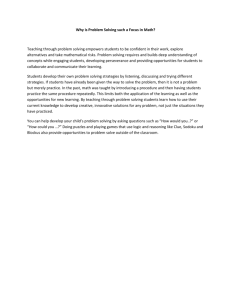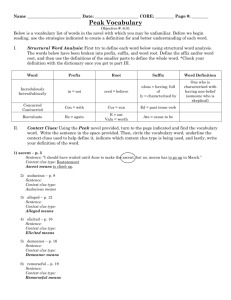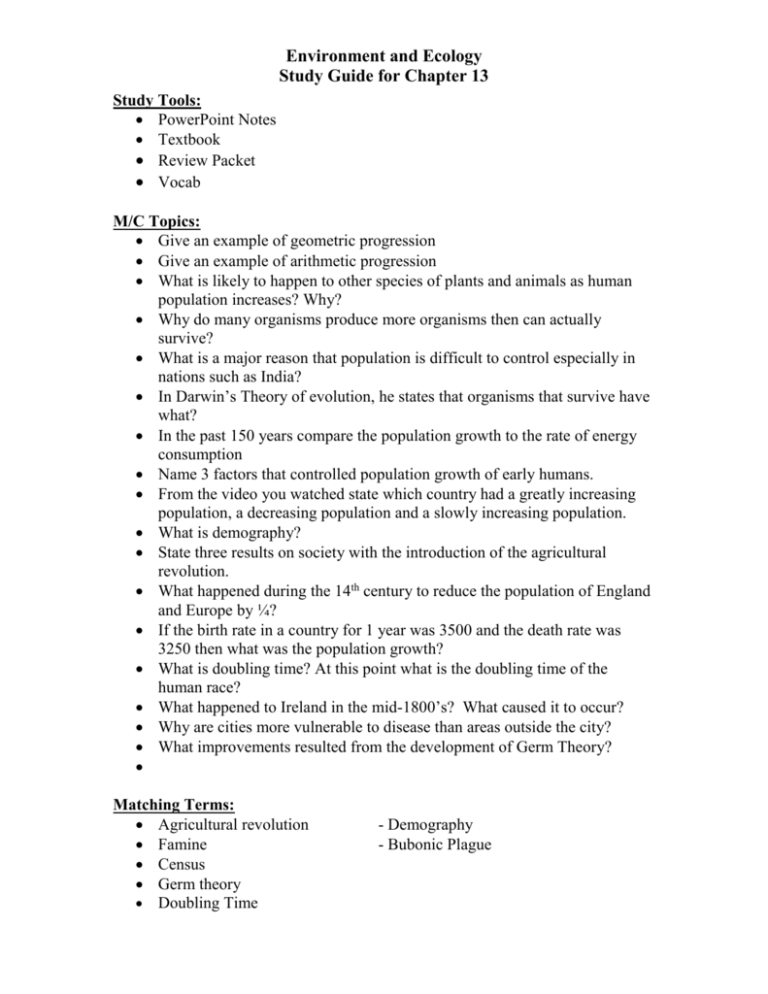
Environment and Ecology
Study Guide for Chapter 13
Study Tools:
PowerPoint Notes
Textbook
Review Packet
Vocab
M/C Topics:
Give an example of geometric progression
Give an example of arithmetic progression
What is likely to happen to other species of plants and animals as human
population increases? Why?
Why do many organisms produce more organisms then can actually
survive?
What is a major reason that population is difficult to control especially in
nations such as India?
In Darwin’s Theory of evolution, he states that organisms that survive have
what?
In the past 150 years compare the population growth to the rate of energy
consumption
Name 3 factors that controlled population growth of early humans.
From the video you watched state which country had a greatly increasing
population, a decreasing population and a slowly increasing population.
What is demography?
State three results on society with the introduction of the agricultural
revolution.
What happened during the 14th century to reduce the population of England
and Europe by ¼?
If the birth rate in a country for 1 year was 3500 and the death rate was
3250 then what was the population growth?
What is doubling time? At this point what is the doubling time of the
human race?
What happened to Ireland in the mid-1800’s? What caused it to occur?
Why are cities more vulnerable to disease than areas outside the city?
What improvements resulted from the development of Germ Theory?
Matching Terms:
Agricultural revolution
Famine
Census
Germ theory
Doubling Time
- Demography
- Bubonic Plague
Environment and Ecology
Study Guide for Chapter 13
Name: _____________________________________________________________ Class: ____________________________________ Date:
_____________________
Chapter 13
Section Review 13.1
Complete the following.
1. What were Malthus’s views about population growth vs. food supply growth?
2. What two rates affect overall population growth? Explain.
3. What event marks the second period of major population growth about 10,000 years ago?
How did this event influence population growth?
4. What era began about 300 years ago and also brought about major population growth?
Explain how.
5. a. What is the germ theory?
b. How has the germ theory helped to contribute to population growth?
6. What are some contributing factors to declines in growth rates?
Review - 57 © Addison-Wesley Publishing Company, Inc. All Rights Reserved.
Name: _____________________________________________________________ Class: ____________________________________ Date:
_____________________
Chapter 13
Section Review 13.2
Complete the following.
1. a. Why is knowing the rate of population growth important?
b. Who might use this information?
2. How are population growth rates determined?
3. What is meant by the doubling time of a population?
4. Other than birth and death rates, what other factors can affect the doubling time of a
population?
5. What is demography?
6. Why do you think industrialized nations generally use more resources than developing
nations?
58 - Review © Addison-Wesley Publishing Company, Inc. All Rights Reserved.
Name: _____________________________________________________________ Class: ____________________________________ Date:
_____________________
Chapter 13
Section Review 13.3
Complete the following.
1. How can overpopulation affect the global ecosystem?
2. What are some obstacles to controlling population size?
3. What are some problems that nations with declining populations face?
4. How might technology remedy some of the problems of overpopulation?
5. Why do some scientists feel that technology cannot solve the problems of overpopulation?
What evidence supports these views?
Review - 59 © Addison-Wesley Publishing Company, Inc. All Rights Reserved.
60 - Review © Addison-Wesley Publishing Company, Inc. All Rights Reserved.
Environment and Ecology
Study Guide for Chapter 13
Name: _____________________________________________________________ Class: ____________________________________ Date:
_____________________
Chapter 13
vocabulary Review
human population
Each clue describes a vocabulary term. Read the clues and write the letters of each vocabulary term on the
blanks.
1. Clue: Period during which hunter-gatherers settled down and developed farming skills.
___ ___ ___ ___ ___ ___ ___ ___ ___ ___ ___ ___
___ ___ ___ ___ ___ ___ ___ ___ ___ ___
2. Clue: Disaster that can devastate a human population, as it did in Ireland.
___ ___ ___ ___ ___ ___
3. Clue: Survey used to determine population size.
___ ___ ___ ___ ___ ___
4. Clue: Scientific development that identified the agents responsible for diseases.
___ ___ ___ ___ ___ ___ ___ ___ ___ ___
5. Clue: Number of years it takes for a population to increase by 100%.
___ ___ ___ ___ ___ ___ ___ ___ ___ ___ ___ ___
6. Clue: Something that declines as a result of improved health and hygiene.
___ ___ ___ ___ ___ ___ ___ ___ ___
7. Clue: Disaster that reduced the population in Central Europe and Asia by about 25 percent.
___ ___ ___ ___ ___ ___ ___ ___ ___ ___ ___ ___ ___
8. Clue: The science of changing vital statistics in a human population.
___ ___ ___ ___ ___ ___ ___ ___ ___ ___
Write the letters found inside the circles on the blanks below. Unscramble them to find the central idea of
the chapter.
Scrambled letters: ___ ___ ___ ___ ___ ___ ___ ___ ___ ___ ___ ___ ___ ___
Solution: ___ ___ ___ ___ ___ ___ ___ ___ ___ ___ ___ ___ ___ ___

